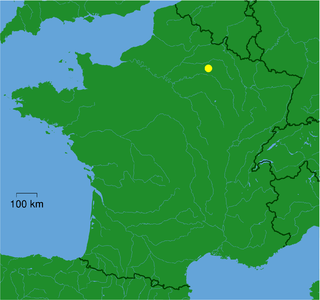Related Research Articles
Ammianus Marcellinus, occasionally anglicised as Ammian, was a Roman soldier and historian who wrote the penultimate major historical account surviving from antiquity. His work, known as the Res gestae, chronicled in Latin the history of Rome from the accession of the Emperor Nerva in 96 to the death of Valens at the Battle of Adrianople in 378, although only the sections covering the period 353 to 378 survive.

Constantius II was Roman emperor from 337 to 361. His reign saw constant warfare on the borders against the Sasanian Empire and Germanic peoples, while internally the Roman Empire went through repeated civil wars, court intrigues, and usurpations. His religious policies inflamed domestic conflicts that would continue after his death.

Julian was Roman emperor from 361 to 363, as well as a notable philosopher and author in Greek. His rejection of Christianity, and his promotion of Neoplatonic Hellenism in its place, caused him to be remembered as Julian the Apostate in Christian tradition.

Valentinian I, sometimes called Valentinian the Great, was Roman emperor along with his brother Valens from 364 to 375. During his reign, he fought successfully against the Alamanni, Quadi, and Sarmatians, strengthening the border fortifications and conducting campaigns across the Rhine and Danube. His general Theodosius defeated a revolt in Africa and the Great Conspiracy, a coordinated assault on Roman Britain by Picts, Scoti, and Saxons. Valentinian founded the Valentinianic dynasty, with his sons Gratian and Valentinian II succeeding him in the western half of the empire.
Paulus Catena (fl. 350s, d. 361/2) was a senior Roman public official who served as an investigator and notary for Constantius II during the mid-fourth century. He is principally known through the writings of Ammianus Marcellinus, though he is also present in the works of Libanius and Julian the Apostate. Marcellinus describes him as infamously cruel, and a skilled fabricator of false accusations.

The siege of Amida was a military investment of the Roman fortified frontier city of Amida by the Sasanian Empire. It took place in AD 359 when the Sasanian army under king Shapur II invaded the eastern provinces of the Roman Empire. Shapur wanted to exploit the absence of the Roman Emperor Constantius II who was overseeing affairs in the western part of the Empire. The city fell, but the strategic gain was little.

Ursicinus was a Roman senior military officer, holding the rank of Magister Equitum per Orientem and even Magister Peditum Praesentalis in the later Roman Empire c. 349–359. He was a citizen of Antioch and was well connected in the Eastern part of the Roman Empire.
Barbatio was a Roman general of the infantry under the command of Constantius II. Previously he was a commander of the household troops under Gallus Caesar, but he arrested Gallus under the instruction of Constantius, thereby ensuring his promotion on the death of Claudius Silvanus. In 359, both he and his wife Assyria were arrested and beheaded for treason against Constantius, possibly as part of a plot by Arbitio, a senior cavalry commander, and another exponent of the forms of scheming and political intrigue that became such a part of the later Roman Empire.
Flavius Arbitio was a Roman general and Consul who lived in the middle of the 4th century AD.
Apodemius was an officer of the Roman Empire, a courtier of Emperor Constantius II, involved in the deaths of Constantius Gallus and Claudius Silvanus.
Serenianus was an officer of the Roman Empire, involved in the death of Caesar Constantius Gallus and in the usurpation of Procopius.
Eusebius was a high-ranking officer of the Roman Empire, holding the position of praepositus sacri cubiculi during the rule of Emperor Constantius II (337-361).
Nevitta was a Roman military leader and official in the Roman Empire. His career is closely linked to that of the emperor Julian. He was master of the cavalry and in 362 served as consul.
Flavius Arintheus was a Roman army officer who started his career as a middle-ranking officer and rose to senior political and military positions. He served the emperors Constantius II, Julian, Jovian and Valens. He was appointed consul in 372 alongside Domitius Modestus.
Dagalaifus was a Roman army officer of Germanic descent. A pagan, he served as consul in 366. In the year 361, he was appointed by Emperor Julian as comes domesticorum. He accompanied Julian on his march through Illyricum to quell what remained of the government of Constantius II that year. He led a party into Sirmium that arrested the commander of the resisting army, Lucillianus. In the spring of 363, Dagalaifus was part of Julian's ultimately-disastrous invasion of Persia. On June 26, while still campaigning, Julian was killed in a skirmish. Dagalaifus, who had been with the rear guard, played an important role in the election of the next emperor. The council of military officers finally agreed on the new comes domesticorum, Jovian, to succeed Julian. Jovian was a Christian whose father Varronianus had himself once served as comes domesticorum.
Nannienus, , was a late Roman military commander in the Western Roman Empire.
Lucillianus was a high-ranking Roman army officer and father-in-law of the emperor Jovian. He fought with success in the war against Persia, and played a part in the execution of the emperor Constantius II's cousin, Gallus. In 361, Lucillianus was kidnapped by the emperor Julian and forced into retirement. He was recalled to service after the accession of his son-in-law Jovian in 363, and given a senior military command, only to be murdered that same year by mutinous troops in Gaul.
References
- ↑ Ammianus, Marcellinus; Rolfe, J.C. (tr). The History XIV 2–7,4–3. Loeb Classical Library. pp. 205–213. Retrieved Mar 19, 2019.
- ↑ Ammianus, Marcellinus; Rolfe, J.C. (tr). The History XIV 16–7,16–8. Loeb Classical Library. pp. 227–235. Retrieved Mar 19, 2019.
- ↑ Woods, David (1995). "The Fate of the Magister Equitum Marcellus". The Classical Quarterly. 45 (1): 266–268. doi:10.1017/S0009838800041963. hdl: 10468/100 . JSTOR 639744.